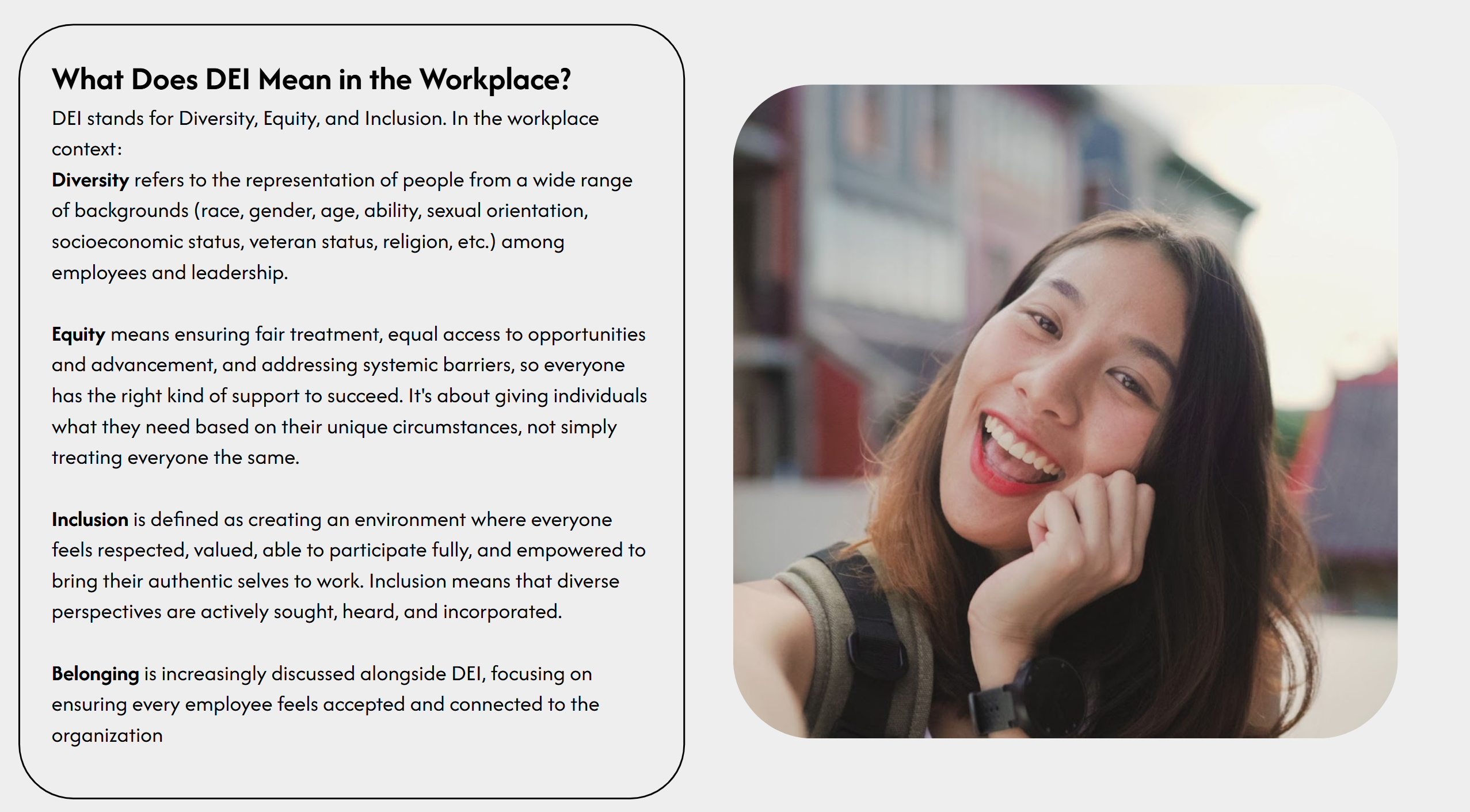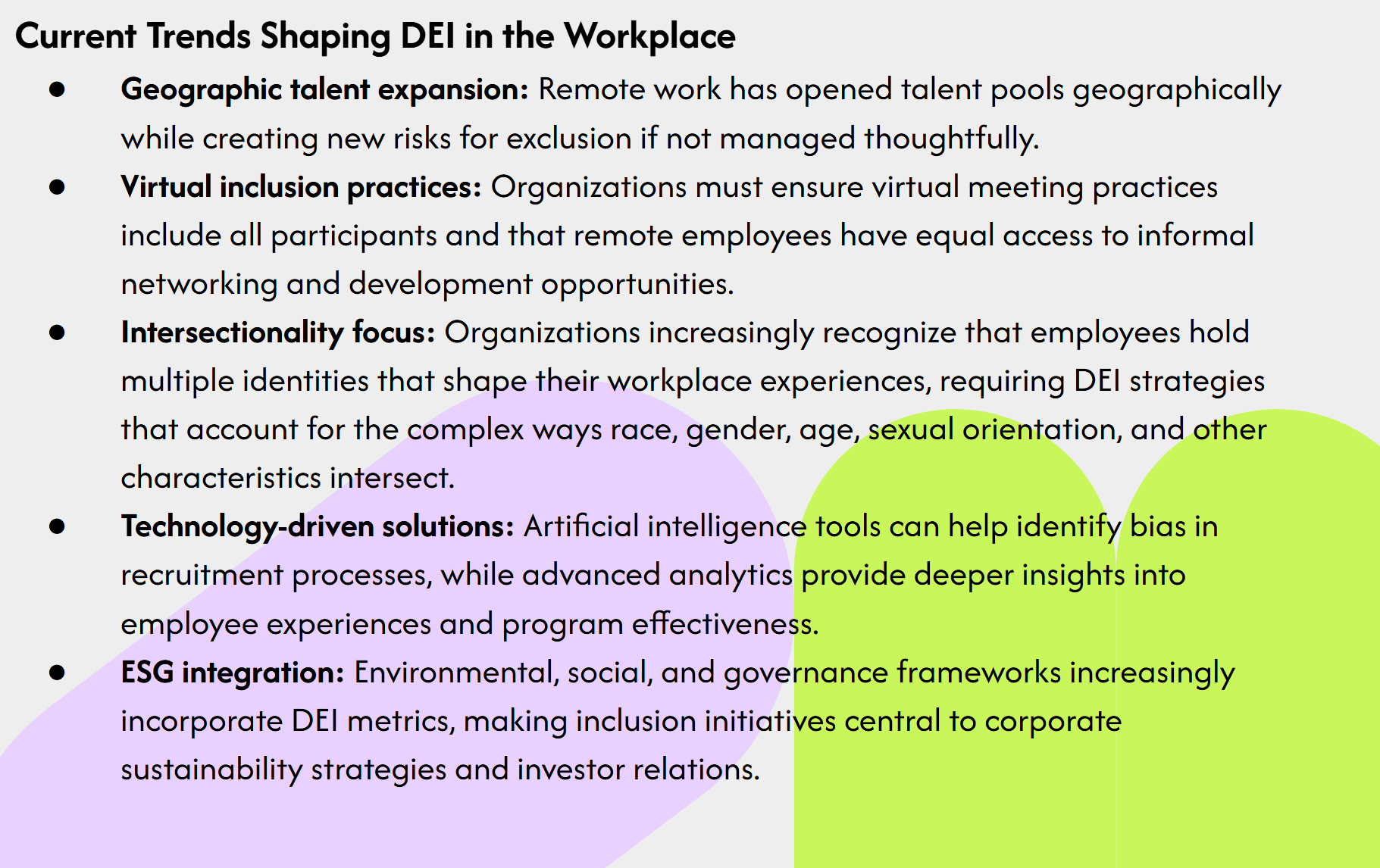As someone who has guided hundreds of organizations through their DEI journey over the past decade, I've witnessed firsthand how thoughtfully implemented DEI in the workplace programs can revolutionize company culture and business outcomes. The statistics speak volumes: companies in the top quartile for ethnic diversity are 36% more likely to outperform their peers financially, while gender-diverse companies show 25% higher profitability.
Understanding the Foundation: What DEI Really Means
Diversity encompasses the full spectrum of human differences represented within your workforce. This includes race, ethnicity, gender identity, sexual orientation, age, physical abilities, socioeconomic background, veteran status, and religious beliefs. True diversity goes beyond surface-level demographics to include diversity of thought, experience, and perspective.
Equity focuses on fairness and justice in workplace practices. Unlike equality, which treats everyone identically, equity recognizes that people start from different places and may need different types of support to succeed. This means examining your promotion processes, compensation structures, and resource allocation through an equity lens.
Inclusion creates an environment where every employee feels genuinely valued, respected, and empowered to contribute their authentic selves. Inclusive workplaces actively seek out diverse perspectives, ensure all voices are heard in meetings, and create psychological safety for employees to share ideas without fear of judgment.
Belonging represents the emotional outcome when diversity, equity, and inclusion work together effectively. Employees who feel a sense of belonging are more engaged, productive, and likely to stay with the organization long-term.

The Compelling Business Case for DEI in the Workplace
The return on investment for DEI in the workplace initiatives extends far beyond compliance and reputation management. Research from McKinsey & Company reveals that diverse executive teams are 33% more likely to see above-average profits, while companies with diverse workforces are 70% more likely to capture new markets.
Innovation thrives in diverse environments because different perspectives challenge conventional thinking and spark creative solutions. When teams include members from varied backgrounds, they're more likely to identify blind spots, anticipate diverse customer needs, and develop products that resonate with broader market segments.
Talent attraction and retention represent another significant advantage. Millennials and Gen Z workers increasingly prioritize working for organizations that align with their values, with 83% of these employees considering diversity practices when evaluating potential employers. Companies with strong DEI reputations spend 20% less on recruiting and experience 40% lower turnover rates.
The decision-making benefits are equally impressive. Diverse teams make better decisions 87% of the time compared to homogeneous groups, and they process information more carefully, leading to more thorough analysis and innovative problem-solving approaches.
Core Components: Building Your DEI Framework
Diversity: Creating Representative Workforces
Effective diversity strategies start with comprehensive workforce analytics. Examine representation across all levels of your organization, from entry-level positions to executive leadership. Look for patterns in hiring, promotion, and retention rates among different demographic groups.
Expand your talent pipeline by partnering with historically black colleges and universities (HBCUs), women's professional organizations, veteran groups, and disability advocacy organizations. Review job descriptions to eliminate unnecessary requirements that might inadvertently exclude qualified candidates from underrepresented groups.
Implement structured interview processes that evaluate all candidates using consistent criteria. Consider using blind resume reviews during initial screening phases to minimize unconscious bias. Train hiring managers on inclusive interviewing techniques and ensure diverse representation on interview panels.
Equity: Ensuring Fair Treatment and Opportunities
Conduct regular pay equity audits to identify and address compensation disparities. Examine promotion rates, performance review scores, and access to high-visibility projects across demographic groups. Create transparent criteria for advancement and ensure all employees understand the pathways to career growth.
Develop sponsorship programs that connect high-potential employees from underrepresented groups with senior leaders who can advocate for their advancement. Research shows that sponsorship is particularly crucial for women and people of color, who often lack access to informal networking opportunities.
Review your benefits packages through an equity lens. Consider offering flexible work arrangements, comprehensive parental leave policies, mental health support, and professional development opportunities that meet diverse employee needs.
Inclusion: Fostering Belonging Daily
DEI in the workplace succeeds when inclusion becomes embedded in daily interactions and organizational practices. Train managers on inclusive leadership behaviors, such as actively seeking input from quieter team members, acknowledging different communication styles, and creating space for diverse perspectives in meetings.
Establish Employee Resource Groups (ERGs) that provide networking, mentorship, and professional development opportunities for employees with shared identities or interests. Support these groups with adequate funding, executive sponsorship, and integration with business objectives.
Create psychological safety by encouraging open dialogue about differences, addressing microaggressions promptly, and celebrating cultural events and traditions that reflect your workforce's diversity. Implement anonymous reporting systems that allow employees to voice concerns without fear of retaliation.
Best Practices for Successful Implementation
Leadership Commitment and Accountability
Successful DEI in the workplace initiatives require visible, sustained commitment from senior leadership. CEOs and executive teams must communicate the business case for DEI regularly, allocate sufficient resources, and model inclusive behaviors consistently.
Establish measurable DEI goals tied to executive compensation and performance evaluations. Create diversity councils or committees with representation from across the organization to guide strategy development and implementation. Regularly share progress updates with all employees to maintain transparency and momentum.
Data-Driven Approach
Use analytics to identify gaps, track progress, and make informed decisions about DEI investments. Collect demographic data responsibly, ensuring compliance with privacy regulations while gathering insights needed to drive change.
Conduct regular employee surveys to assess inclusion climate, psychological safety, and sense of belonging. Supplement quantitative data with focus groups and listening sessions that provide qualitative insights into employee experiences.
Monitor key metrics including representation rates, promotion patterns, retention statistics, and employee engagement scores across different demographic groups. Use this data to identify trends, celebrate successes, and adjust strategies as needed.
Continuous Learning and Development
Implement comprehensive DEI education that goes beyond one-time training sessions. Develop ongoing learning programs that address unconscious bias, cultural competency, inclusive leadership, and allyship skills. Tailor content to different roles and levels within the organization.
Create learning pathways that help employees understand how their individual actions contribute to broader inclusion goals. Provide resources for self-reflection and skill development, including books, podcasts, webinars, and mentoring opportunities.
Current Trends Shaping DEI in the Workplace
The hybrid work environment has introduced new challenges and opportunities for DEI in the workplace practitioners. Remote work has opened talent pools geographically while creating new risks for exclusion if not managed thoughtfully. Organizations must ensure virtual meeting practices include all participants and that remote employees have equal access to informal networking and development opportunities.
Intersectionality has gained increased attention as organizations recognize that employees hold multiple identities that shape their workplace experiences. DEI strategies must account for the complex ways that race, gender, age, sexual orientation, and other characteristics intersect.
Technology is revolutionizing DEI measurement and implementation. Artificial intelligence tools can help identify bias in recruitment processes, while advanced analytics provide deeper insights into employee experiences and program effectiveness.
Environmental, social, and governance (ESG) frameworks increasingly incorporate DEI metrics, making inclusion initiatives central to corporate sustainability strategies and investor relations.

Practical Steps to Begin Your DEI Journey
Start with a comprehensive assessment of your current state. Analyze workforce demographics, review policies and practices, and survey employees about their inclusion experiences. This baseline measurement will guide your strategy development and provide benchmarks for progress tracking.
Form a diverse working group to lead your DEI in the workplace initiative. Include representatives from different departments, levels, and demographic groups to ensure varied perspectives inform your approach. Establish clear roles, responsibilities, and decision-making authority for this group.
Develop a multi-year strategic plan with specific, measurable objectives. Focus on 2-3 key areas initially rather than trying to address everything simultaneously. Common starting points include inclusive hiring practices, manager training, and employee resource group development.
Communicate your commitment transparently with all stakeholders. Share your DEI vision, goals, and initial action steps with employees, customers, and investors. Regular communication builds trust and accountability while encouraging participation in your initiatives.
Measuring Success and Sustaining Progress
Effective measurement combines quantitative metrics with qualitative feedback. Track representation statistics, but also assess whether employees from all backgrounds feel valued, heard, and positioned for success. Use both data sources to identify areas for improvement and celebrate achievements.
Create feedback loops that allow for continuous improvement. Regularly solicit input from employees about their experiences and suggestions for enhancement. Use this feedback to refine your approach and address emerging challenges promptly.
Transform Your Organization Today
DEI in the workplace represents one of the most significant opportunities for organizational transformation and competitive advantage available to modern businesses. The evidence is clear: companies that embrace diversity, equity, and inclusion outperform their peers across virtually every meaningful business metric.
Success requires sustained commitment, adequate resources, and willingness to examine and change long-standing practices. Start with small, concrete steps while building toward comprehensive culture change. Remember that DEI is a journey, not a destination, requiring ongoing attention and evolution.
Ready to begin your DEI transformation? Start by conducting an honest assessment of your current state, engaging leadership in meaningful dialogue about the business case for change, and identifying 2-3 initial focus areas where you can make measurable progress within the next 90 days. Your employees, customers, and bottom line will thank you for taking this critical step toward building a more inclusive, innovative, and successful organization.
